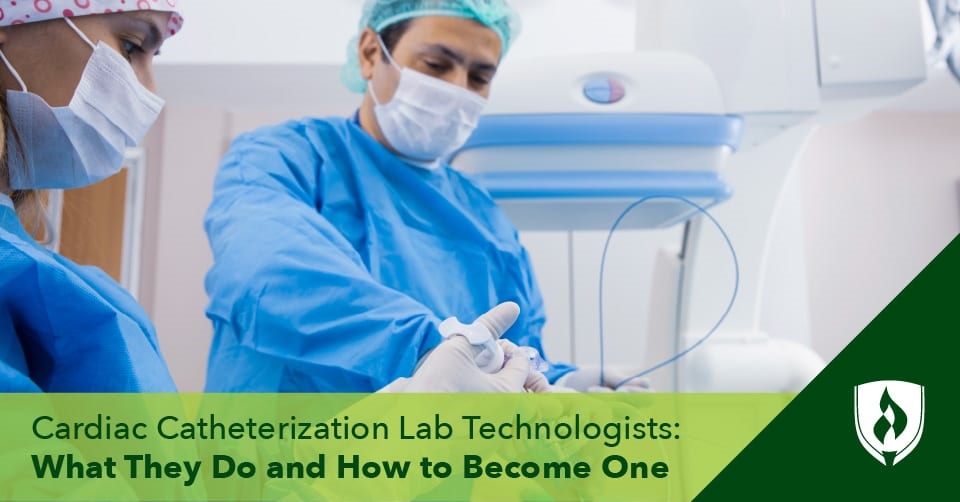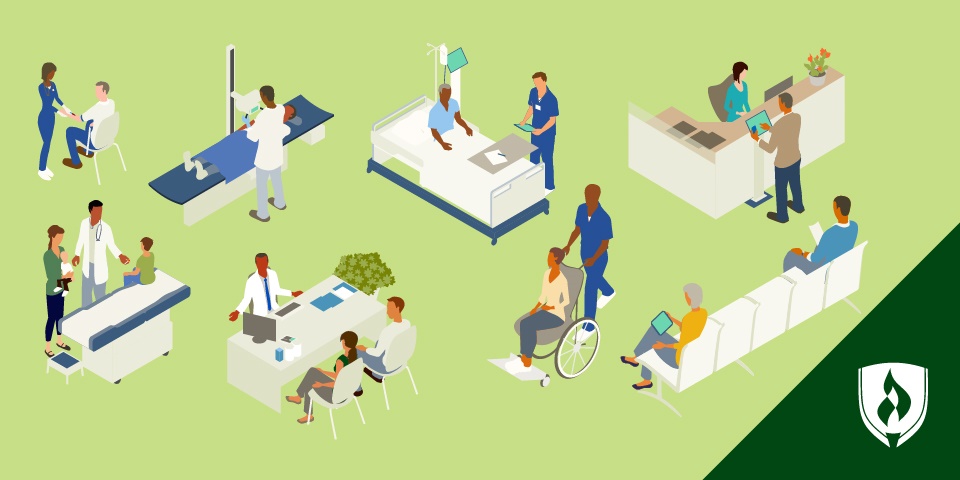Cardiac Catheterization Lab Technologists: What They Do and How to Become One
By Kirsten Slyter on 09/12/2022
You’ve always been drawn to the healthcare field, and the high-impact, high-intensity work that comes along when dealing with serious health conditions sounds like it could be the perfect fit for you. While there are certainly several healthcare roles that share this appeal, working in the cardiac catheterization lab as a diagnostic imaging specialist is one option that’s caught your attention.

Whether you’re an established radiologic technologist or allied healthcare professional, or you’re just considering potential healthcare career options, this niche role is certainly worth further exploration and consideration.
In this article, you’ll learn more about what the “cath lab” is used for, the role and responsibilities of cardiac cath lab technologists, and what it takes to get started in this specialty role.
What is the cardiac “cath lab” used for?
The catheterization laboratory is set up to help patients who can benefit from the use of diagnostic imaging equipment to visualize arteries and treat any abnormalities found. Many cath lab procedures are generally considered safer and less invasive than surgery and can help patients avoid or postpone riskier procedures like open-heart surgery.
Common cardiac cath lab procedures can include:
- Heart tissue biopsies
- Atherectomies: Minimally invasive procedure for removal of plaque from an artery
- Balloon angioplasties: Procedure used for breaking up arterial plaque and stretching of a vessel to allow for additional blood flow
- Percutaneous Coronary Intervention (PCI): Treatment stenosis of coronary arteries
- Septal closure device placement: For treatment of atrial septal defects
- Stenting: Placement of a device to help vessels stay open
- Thrombectomies: The removal of debris or a clot from an artery at the point of formation
Conducting these procedures is a team of healthcare specialists, including interventional cardiologists, registered nurses and catheterization lab technicians.
What is a cardiac cath lab tech?
Cardiac catheterization procedures require highly specialized equipment to be successful, and cardiac cath lab techs are the team members tasked with operating these critical tools. Like other types of radiologic technologists, these techs operate specialized diagnostic imaging equipment while patients undergo cath lab procedures. To get an idea of what that looks like, let’s walk through an example.
Before a procedure starts, the cardiac cath lab tech will prepare the sterile procedure tray and ensure the lab is equipped with anything the team will need during the procedure. Cath lab procedures, while typically minimally invasive, must still be conducted in a sterile environment to prevent infection—that means all staff must scrub in and help protect the sterile field once in the lab. Once the patient is in the lab, the cath lab tech sets to work on prepping the patient, preparing the incision site and providing any comfort they can to the patient.
During the procedure, the cath lab tech will work with fluoroscopes or other imaging equipment to help the physician guide the catheter on its way to the heart. This is done with the help of a specialized contrast dye that provides a clearer picture of the patient’s heart and blood vessels. The tech may also function as a first assist and help keep an eye on patient vitals, including specific cardiac measurements like pressure tracings and the electrocardiogram (EKG) rhythm.
Additionally, some cardiac cath lab techs may be tasked with administering medication depending on the state, the hospital and the professional’s specific credentialing.
How to become a cardiac cath lab tech
There are several different paths you can take to become a cardiac cath lab tech. While it can be confusing to decide which path is best for you, it’s worth checking your state health department’s scope of practice for cath lab techs and reviewing job descriptions for local hospitals to get a sense of what credentials they look for most commonly.
Typically, working in invasive cardiology requires more training than noninvasive testing like resting EKGs, stress testing or echo cardiology.
Employers typically look for either certified radiologic technologists or cardiovascular technicians and other related allied health professionals who have earned a Registered Cardiovascular Invasive Specialist (RCIS)® certification.
Radiologist technologists must be certified by the American Registry of Radiologic Technologists® (ARRT) or an equivalent organization, which means completing an associate’s or bachelor’s program, passing the ARRT exam and receiving your primary credentials. Additionally, prospective cardiac cath lab techs will likely want to pursue Advanced Cardiovascular Life Support (ACLS) certification as well as the ARRT’s Vascular Interventional Radiology credential.
After graduating, would-be cardiac cath lab techs may first want to build related experience in a hospital or clinic. Given the relatively high stakes of catheterization lab procedures, it’s helpful to have a strong foundation of experience working with a lower-acuity patient population first.
Cardiac catheterization lab tech skills
So what does it take to be effective in this role? Cath lab techs will need a strong grasp on how to use and maintain diagnostic imaging equipment, patient anatomy, sterile procedures and other critical technical knowledge that can be developed in an academic program.
Beyond the technical skills needed, cath lab techs will also need a solid mix of soft skills and tendencies to be an effective member of the team.
The cardiac cath lab can be an intense place, as mistakes can come with life-threatening consequences for the patient. Cath lab techs need to have a perfectionist’s eye for detail—whether that’s in the form of being absolutely sure all equipment is prepared and ready for a procedure, maintaining a sterile field or monitoring a patient for signs of trouble during a procedure.
Additionally, the ability to keep calm, communicate effectively and work seamlessly as a team member during high-pressure situations is critical. Physicians often have demanding expectations of their support team, and being able to listen to their directions and adapt as needed without getting flustered is a big plus.
Could a cath lab tech career be in your future?
Working in the cath lab can be a fulfilling way to find your place in healthcare. Seeing the tangible, life-extending impact interventional cardiology has on patients is an undeniably rewarding experience—and you too could get in on the action.
One of the most straightforward ways to working in the cardiac catheterization lab is to first get established as a radiologic technologist. Learn more about your first step in our article “How to Become a Radiologic Technologist: Examining Your Path.”
Registered Cardiovascular Invasive Specialist (RCIS) is a registered trademark of Cardiovascular Credentialing International Corporation.
American Registry of Radiologic Technologists (ARRT) is a registered trademark of The American Registry of Radiologic Technologists Corporation.

-(1).png)


